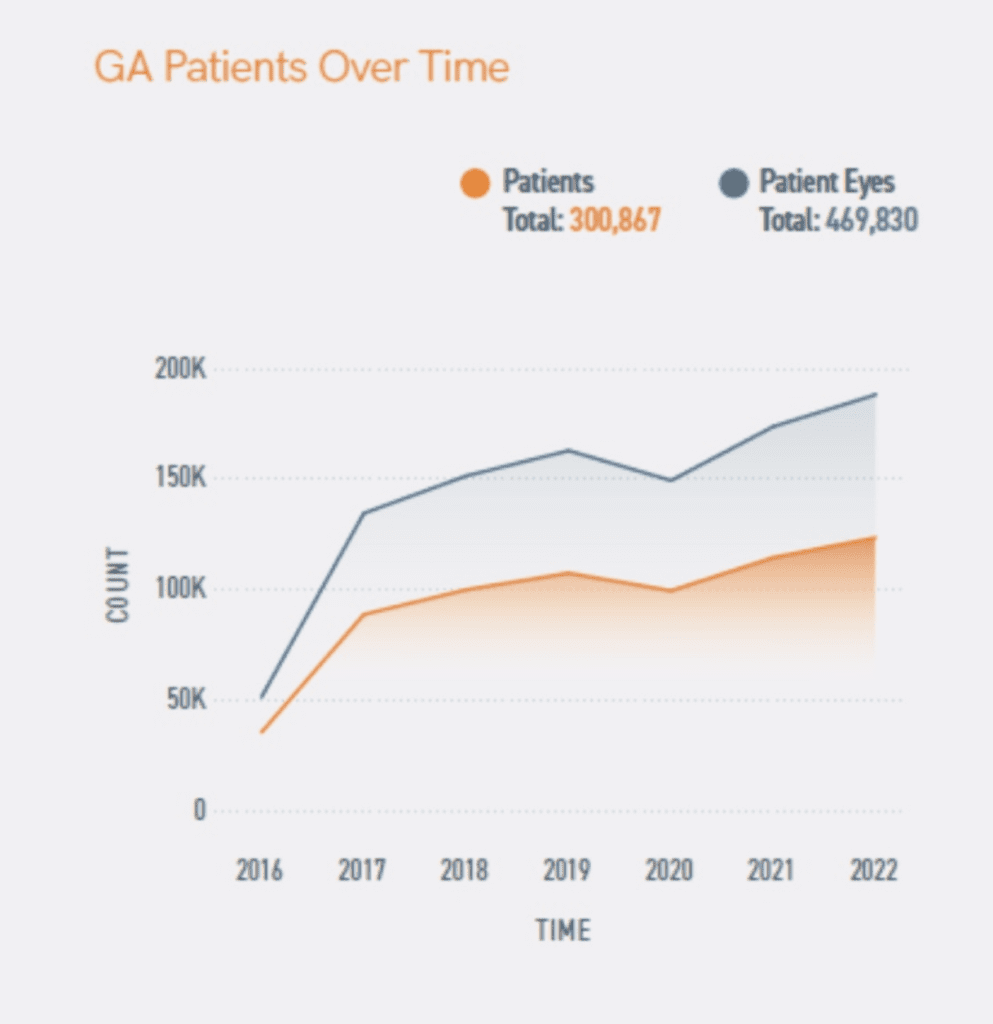Highlights from the 2022 IRIS Registry Report

Author:
Mike Mbagwu, MD
Verana Health recently released the 2022 annual report on our partnership with the American Academy of Ophthalmology (Academy) IRIS® Registry (Intelligent Research in Sight). As the Academy’s data curation and analytics partner, Verana Health directly ingests electronic health record (EHR) data into VeraQ®, our population health data engine. Direct ingestion offers a refresh rate that is nearly four times faster than in the past, while enhancing data fidelity and traceability.
Among the highlights of the report (the full text may be requested here) are the large and growing volume of data available in the IRIS Registry. In 2022 alone, clinicians reported more than 51 million patient visits to the IRIS Registry. Cumulatively, more than 490 million billable patient encounters have been added to the IRIS Registry since 2013, making it possible to rigorously analyze trends over time.
Longitudinal EHR data on anti-VEGF injections for six key treatment indications, for example, provide a rich source of information for life sciences companies. Using the Qdata Anti-VEGF Market Tracker, powered by de-identified real-world data from the IRIS Registry, Verana Health can actively track the usage of anti-VEGF therapies and provide granular market segmentation and patient outcomes down to the brand level. This will be helpful to life sciences companies investigating the value of switching medications or trying to evaluate the safety of new biosimilar anti-VEGF agents that are soon to enter the marketplace.
Longitudinal data from the IRIS Registry also show that ophthalmic procedure volumes recovered quickly after the COVID-19 shutdown in 2020, and are now continuing to rise at a similar or faster annual rate than before the pandemic.
The 2022 annual report takes a close look at dry age-related macular degeneration (dry AMD) and geographic atrophy (GA). The availability of GA data in the IRIS Registry has grown in recent years, from 52,000 eyes of 36,000 patients in 2016 to nearly 470,000 eyes of more than 300,000 patients currently (Figure 1). On average, patients in the GA cohort had 13.72 clinic visits with associated notes in total and an average of 3.15 ± 2.38 years of follow-up. GA patients are concentrated in the Southern region of the U.S., where 39% reside. Nearly three-quarters of them are followed by retina specialists, but a substantial number are cared for by other ophthalmologists or optometrists.

Research analyzing IRIS Registry data is already beginning to illustrate risk factors for progression in dry AMD and GA in a real world population. In the first known study of its kind, real-world data was used to characterize the distribution of patients with dry AMD by both visual acuity (VA) and disease severity for all stages of dry AMD.1 Another study explored the differences in VA for patients with either bilateral GA or unilateral GA with contralateral CNV, as well as subfoveal vs. non-subfoveal lesions.2
Verana Health is poised to meet the need for deeper exploration of GA with Qdata GA, a thoughtfully curated data set that incorporates fundus photography, optical coherence tomography, fundus auto-fluorescence, and structural measurements obtained from imaging, such as lesion size and subfoveal thickness. Imaging data, along with other variables such as VA, can be used to better identify GA subtypes, risk factors for progression, and treatment responder characteristics.
I’m very excited about the work that we have done to directly ingest EHR data, link millions of images, and create highly curated datasets. This uniquely positions Verana Health to contribute to the ongoing scientific conversation about a wide range of disease states in ophthalmology and to tackle research questions in new and powerful ways. I invite you to request a copy of the report here.
References:
- Leng T, et al. Dry age-related macular Degeneration: Distribution of visual acuity and progression risk in a large registry. Ophthalmol Ther 2023;12:325-40.
- Khan MAA, et al. Retrospective cohort analysis of patients with geographic atrophy (GA) secondary to age-related macular degeneration followed for 3 years in clinical practice. Invest Ophthalmol Vis Sci 2022;63(7):300.

Let's Accelerate Research Together
To learn more about Verana Health, please fill out the information below and our team will follow up with you as soon as possible.

